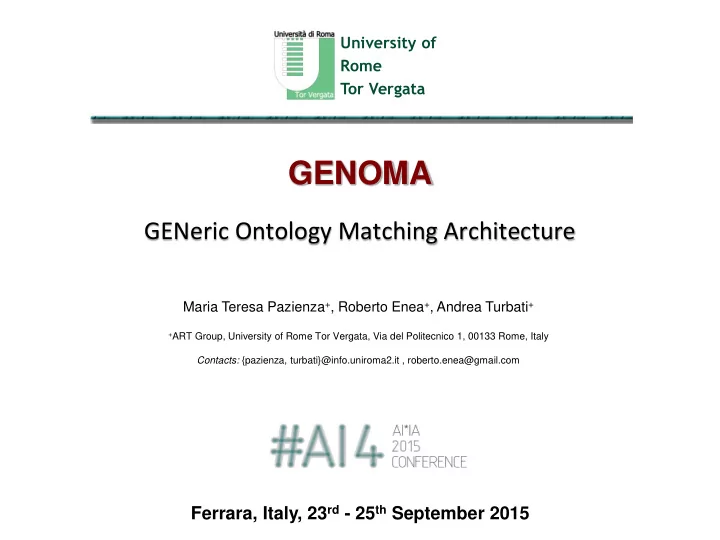

University of Rome Tor Vergata GENOMA GENeric Ontology Matching Architecture Maria Teresa Pazienza + , Roberto Enea + , Andrea Turbati + + ART Group, University of Rome Tor Vergata, Via del Politecnico 1, 00133 Rome, Italy Contacts: {pazienza, turbati}@info.uniroma2.it , roberto.enea@gmail.com Ferrara, Italy, 23 rd - 25 th September 2015
The Ontology Matching Problem Ontology development became a very frequent task. In creating a new ontology two possible approaches exist: 1. starting from a shared vocabulary (as the FOAF ontology when describing people-related terms) and then enriching the new domain with specific info 2. defining everything from scratch . As a consequence, using more than one ontology in a new task can be extremely difficult, since different resources of distinct ontologies (classes/instances/properties identified by different lexicalizations ) can be used to identify the same concept. 2
The Ontology Matching Problem While humans naturally deal with such an ambiguity and try to understand the similarity between these resources, systems cannot easily do the same. This means that even when using a formal representation for an ontology (with a given serialization), the richness of the natural language is still an issue! 3
The Ontology Matching Problem Ontology Matching as the branch of the Ontology Engineering that aims in finding similarities between resources of two or more ontologies. The input to the framework consists in two or more ontologies from which, using a matcher (single or multiple one), an alignment matrix is produced. 4
Ontology Matching Tools Main differences among existing O.M. tools are: • the size of the ontologies they are able to manage • the formal language in which the ontologies should be written (mostly RDF and one of its serialization, such as RDF/XML or N-Triples) • which resources they are able to compare (classes, instances, properties) • the natural languages in which the two ontologies should be written (or if they are able to compare ontologies written in different languages); • the cardinality of the output alignment for each resource it returns ( 1:1 or n:m ) • open source or proprietary (a common problem when dealing with any software tools) • if they use external data or not (this can affect their license as well); • adoption of just syntactic matching or also some sort of semantic matching approach 5
O.M Tools: Comparison Falcon ASMOV Cupid iMap GLUE COMA++ Specific for big Yes No No No No No ontologies Input RDF/RDFS/ OWL XML XML, DB Schemas XML, DB Schemas RDF/RDFS/ OWL OWL Resources matched Classes + Properties + Classes + Properties XML XML, DB schema XML, Classes + Instances Elements Elements DB schema Properties Elements Specific No English English No No English Natural languages Output 1:1 m:n 1:1 1:1 1:1 1:1 alignment Open source Yes No No No No Yes Linguistic resources No WordNet WordNet No No WordNet Type of matching Linguistic Structural Linguistic Structural Linguistic Structural Parallel searcher + Statistical Approach, Linguistic Extensional similarity estimator Machine learning 6
expectations … A generic architecture to help either experts or beginners to assemble matchers in different modalities and choose the best combination given a specific application context. 7 14th AI*IA Conference, Ferrara, Italy
GENOMA Gen.O.M.A ( Gen eric O ntology M atching A rchitecture) or GENOMA is a sort of meta architecture helping in developing new specific architectures for the ontology matching task. Some of its main features: • WYSIWYG tool for the composition of the matching architecture • Reusability of the matchers/use of newly created ones • Expandability of the matcher’s dictionary • Deployable on distributed systems 8
GENOMA : Architecture 9
GENOMA : User Interface To help the user in creating, visualizing and validating an architecture for an O.M. tool, GENOMA provides an easy to use and complete User Interface 10 10
GENOMA : User Interface Creating a new architecture is completely interactive and mouse oriented activity • By selecting the desired matcher, the user specifies the parameters values (or accepts the default ones) • Then link the matchers in several possible deployment configurations. All this is achieved easily by using just a few clicks of the mouse 11 11
GENOMA : Examples By first, in defining an architecture, the user decides whether to adopt a parallel or a series approach given two matchers. Two base configurations: 12 12
GENOMA GENOMA is an architecture that helps developing, deploying and validating complex and totally customizable O.M. architecture and tools. These architectures can be changed any time, to find the better one given a specific domain or application needs, leaving the user the complete freedom of experimenting while defining its architecture. download from: http://bitbucket.org/aturbati/ontology-matching-architecture 13 13
Recommend
More recommend